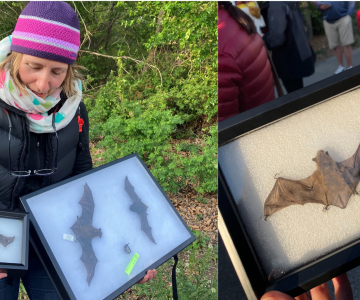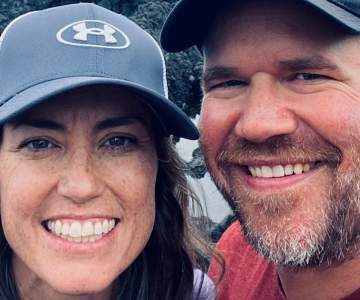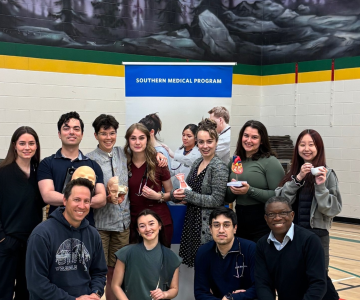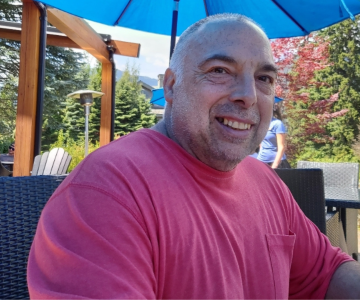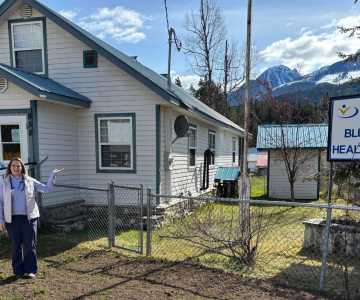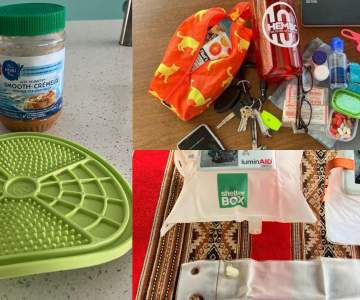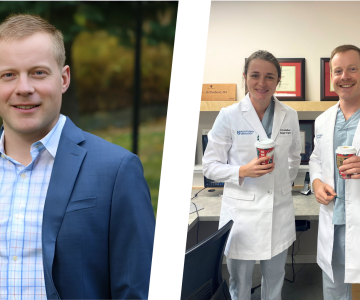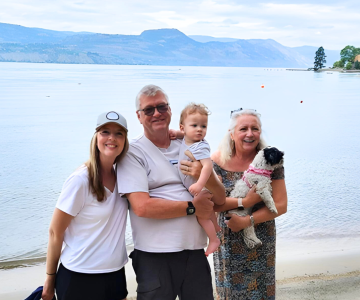Breadcrumb
Explore Stories
Health & Wellness
Barbara was enjoying the sunset on her porch on a warm summer evening in Penticton when a bat fell on her legs.
“It flapped around a bit, fell on the deck, flapped around a bit more, then flew away,” she recalls. “I felt its soft, skin-like wings on my legs. My husband and I looked at each other, shrugged, and carried on with our evening.”
A few days later, she recounted the story to a friend. “She told me to get myself to the hospital. I learned that you should get a rabies shot after any interaction with a bat because they can leave tiny scratches you may not notice.”
Barbara jokingly posted this photo on her Facebook page after her encounter with a bat and visit to the hospital.Bats are fascinating mammals that play an essential role in B.C.'s ecosystem and provide natural pest control. They can eat their weight in insects (including mosquitoes) in one night. All bats in Canada eat nothing but insects and arachnids (spiders and scorpions), and in most cases, only flying insects. Half of the species in B.C. are considered vulnerable or threatened.
But love them or loathe them, bats can also carry diseases that can be transmitted to humans, including rabies. Rabies is a very serious disease caused by a rabies virus. It's transmitted through saliva (spit), usually by the bite of a mammal. If not treated in time, a rabies infection is almost always fatal. It’s important to know that it typically takes 3–8 weeks before rabies symptoms start in humans—but can be much longer. If you wait until the symptoms appear, it’s usually too late to start effective medical treatment.
In B.C., between four and eight per cent of bats that come into contact with people test positive for the rabies virus. When the general population of bats is randomly sampled, less than 0.5 per cent of bats tested positive for rabies. In 2024, 140 people in the region were treated for potential exposure to rabies.
Community & Culture
Name: Erik Reimer (he/him/his)Job Title: Spiritual Health PractitionerYears of Service: Seven monthsWorksite: Vernon Jubilee HospitalCommunity: VernonAncestral Territory: syilxFavourite Quote / Advice to live by: “Shame and insecurity intimidate us into hiding. Connection and belonging invite us to step out into the open.”
Meet Erik Reimer, the newly appointed spiritual health practitioner at Vernon Jubilee Hospital (VJH). Erik brings a wealth of experience in spiritual care, having spent more than two decades as a pastor walking alongside people through life’s most significant moments.
His journey is not just one of academic learning and teaching, but of profound personal reflection and empathy that undoubtedly resonates with those he serves.
Community & Culture
From May 5-9, 2025, the Healthcare Travelling Roadshow made its way to high schools in Salmo, Creston and Lumby. More than 450 students got to roll up their sleeves and explore real-world health-care careers through hands-on activities and face-to-face learning.
With a team of nine post-secondary health-care students leading the way, the annual Roadshow offers an interactive and engaging look into the many opportunities in the health-care sector. The Roadshow aims to inform, inspire and spark interest in exciting future careers.
Health & Wellness
Algae are a natural part of the aquatic ecosystems of lakes and algae blooms can occur throughout the Interior Health region.
Blue-green algae are actually a microscopic bacteria called cyanobacteria. Cyanobacteria can live in waters through winter. In the warmer spring and summer months, cyanobacteria can multiply very quickly and produce several types of toxins that can be poisonous to people, pets and livestock.
“It’s that time of year when we can see increased blue-green algae (cyanobacteria) blooms on lakes. These blooms tend to stay on the water surface and may have a leafy scent,” says Interior Health medical health officer Dr. Andy Delli Pizzi. “Sometimes blooms can be toxic for those who come in contact with the water. My advice is to use common sense and avoid contact or consuming water if you suspect there is a cyanobacteria bloom.”
Community & Culture
Name: Robert GignacJob Title: Care AideYears of Service: 35Worksite: Parkview PlaceCommunity: EnderbyAncestral Territory: Secwépemc NationFavourite Quote / Advice to live by: “It’s better to give than to receive.”
Since joining Parkview Place in 2012, Robert Gignac has left his mark on the long-term care home. He has greeted people with a smile as a screener, helped things run smoothly behind the scenes, and most recently, has been serving residents as a care aide.
Most importantly, Robert always tries to leave residents smiling after an interaction.
“When I work with some of my residents, they ask, ‘What is your name?’ When I say, ‘Mr. Wonderful,’ they burst out laughing,” Robert says.
Community & Culture
Name: Bettina Panio (she/her/hers)Job Title: Certified Practice Registered Nurse (RN)Years of Service: 13Worksite: Blue River Health Centre, Clearwater, Dr. Helmcken Memorial Hospital & Kamloops Royal Inland Hospital (ED & ICU)Community: Louis CreekAncestral Territory: SecwepemcFavourite Quote: I love quotes that touch me and call to me. There are too many to chose from but since this is about nursing, I really like this quote, “Value what you do and add value by what you do.”Advice to Live By: Be like a tree: Stand tall and proud. Stay grounded. Connect with your roots. Turn over a new leaf. Bend before you break. Go out on a limb. Drink plenty of water. Be content and enjoy your unique natural beauty. Keep growing. Enjoy the view.
A desire to expand the scope of her practice, coupled with great family support, has led Certified Practice Registered Nurse Bettina Panio to try a new position at Interior Health (IH) in the remote community of Blue River.
Since November 2024, Bettina has been providing care two days a week for clients at the Blue River Health Centre. The centre, located between Clearwater and Valemount along Highway 5, is based out of the historic Blue River Outpost building which was established as a first aid clinic in 1948.
Health & Wellness
“Preparedness is not a luxury. It’s a necessity.”
That’s the message Interior Health’s (IH) Health Emergency Management BC (HEMBC) team wants to get across to our communities as British Columbia emergency agencies prepare for another unpredictable wildfire season. And, with temperatures warming up, now is the time to review your emergency plan and take stock of your emergency kit, so you’re prepared.
While there are some fundamental items that should always live in your kit—water, food, a battery-operated or wind-up flashlight and radio, personal medications, extra keys and cash—everyone’s personal situation is unique and there are no rules for what you can or can’t add to those basic supplies.
Community & Culture
Name: Mike Robinson (he/him/his)Job Title: UrologistYears of Service: 10Worksite: Kootenay Boundary Regional Hospital (KBRH)Community: TrailAncestral Territory: Sinixt, syilx and Ktunaxa
Raised in the small lakeside town of Christina Lake, B.C., Dr. Mike Robinson always knew the West Kootenays would be part of his story. What he didn’t know, as a young student passionate about human physiology, was that he would one day become a cornerstone of surgical care in the region he calls home.
After completing his undergraduate degree in Human Kinetics and Exercise Physiology at the University of British Columbia (UBC), Dr. Robinson continued to medical school through UBC’s Northern Medical Program in Prince George, as part of only the second cohort of this innovative, community-based initiative.
He later returned to Vancouver for a surgical residency at UBC and spent a year working locum positions in Vancouver before ultimately finding his professional home in Trail.
Community & Culture
Doug Berry says after a lengthy journey to his cancer diagnosis and treatment, he is thankful for the travel support he received through the Cancer Travel and Accommodation Services (CTAAS) program.
In 2023, Doug had visited Mexico for his daughter’s wedding. For years, he had been experiencing soreness and itchiness on his skin. During the trip, the Sicamous resident saw a new dermatologist who suggested he undergo a biopsy.
“Two weeks later, I received a letter saying I should visit an oncologist,” Doug recalls. “It was a bit of a shock, but I called my doctor right away.”
-
Load More
Showing 81 of 805
Sign up for email updates
Receive news, alerts, public service announcements and articles right to your inbox.


